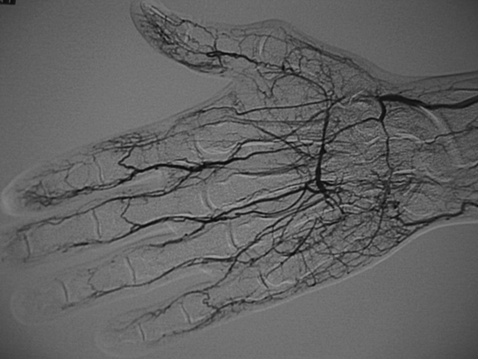Fig. 23.1 Clinical appearance of a patient with Raynaud’s disease. Discoloration and ulcerations are common physical findings.

Fig. 23.2 A typical angiogram of a patient with Raynaud’s disease showing diffuse vasospasm of digital arteries.
Response to different treatment options varies and is difficult to predict. Initial conservative treatment methods include avoidance of exacerbating factors, particularly cold, stress and smoking. Various medications have been employed to improve blood flow and decrease pain, with variable results (Box 23.1). Pharmacologic treatments include calcium channel blockers, nitric oxide, angiotensin-converting enzyme inhibitors, selective serotonin receptor inhibitors, alpha-adrenergic blockers, anticoagulants, antithrombotics and antioxidants. Patients with severe pain and digit ulceration who have failed conservative managements are often referred to hand surgeons for further evaluation and treatment. Historically, cervical sympathectomy was a surgical treatment option but it has now fallen out of favor because of potential complications and poor long-term results (de Trafford et al., 1988). Adrian Flatt introduced digital sympathectomies for chronic ischemia, where the vessels are surgically stripped of the adventia and sympathetic innervation. The intent is to deny the digital artery of its potential to vasoconstrict. Microsurgical digital artery sympathectomy is localized surgical treatment that involves removing the adventitia from involved arteries at the level of the digital artery, palmar common digital artery, palmar arch and/or radial and ulnar arteries. Theoretically, this treatment irreversibly prevents sympathetically mediated vasoconstriction; however, it provides inconsistent relief and is often associated with surgical morbidity. Partial or full amputations may be necessary to relieve recalcitrant pain and ulcerations. The implications of amputation on quality of life are obvious. These less-than-optimal therapies leave much room for improvement for the treatment of digit ischemia associated with Raynaud’s disease.
Sympatholytics
- clonidine
- phentolamine
- prazosin
- phenoxybenzamine
- propanolol
- Calcium channel blockers
Anticoagulants
- aspirin
- dipyridamole
Nitrates
Angiotensin-converting enzyme inhibitors
Anticonvulsants
- gabapentin
- phenytoin
- carbamazepine
- clonazepam
- valproic acid
Antidepressants
Selective serotonin receptor inhibitors
Calcitonin
Botulinum neurotoxin for Raynaud’s disease
There have been five studies since 2004 that have evaluated the use of botulinum neurotoxin type A (BoNT-A) for the treatment of Raynaud’s disease (Sycha et al., 2004; Van Beek et al., 2007; Fregene et al., 2009; Neumeister et al., 2009; Neumeister, 2010) (Table 23.1). Although these studies have many limitations, such as lack of controls, varying severity of disease and variability of dosing, all reported favorable clinical results, with overall improvement in patient pain and reduction in soft tissue ulceration. There is no information in the literature about BoNT-B.
Stay updated, free articles. Join our Telegram channel

Full access? Get Clinical Tree


